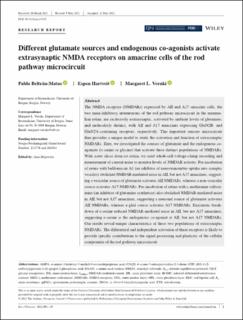| dc.contributor.author | Beltran Matas, Pablo | |
| dc.contributor.author | Hartveit, Espen | |
| dc.contributor.author | Veruki, Margaret Lin | |
| dc.date.accessioned | 2021-08-13T07:36:24Z | |
| dc.date.available | 2021-08-13T07:36:24Z | |
| dc.date.created | 2021-06-24T19:20:34Z | |
| dc.date.issued | 2021 | |
| dc.identifier.issn | 0953-816X | |
| dc.identifier.uri | https://hdl.handle.net/11250/2767701 | |
| dc.description.abstract | The NMDA receptors (NMDARs) expressed by AII and A17 amacrine cells, the two main inhibitory interneurons of the rod pathway microcircuit in the mammalian retina, are exclusively extrasynaptic, activated by ambient levels of glutamate, and molecularly distinct, with AII and A17 amacrines expressing GluN2B- and GluN2A-containing receptors, respectively. This important sensory microcircuit thus provides a unique model to study the activation and function of extrasynaptic NMDARs. Here, we investigated the sources of glutamate and the endogenous co-agonists (d-serine or glycine) that activate these distinct populations of NMDARs. With acute slices from rat retina, we used whole-cell voltage-clamp recording and measurement of current noise to monitor levels of NMDAR activity. Pre-incubation of retina with bafilomycin A1 (an inhibitor of neurotransmitter uptake into synaptic vesicles) abolished NMDAR-mediated noise in AII, but not A17 amacrines, suggesting a vesicular source of glutamate activates AII NMDARs, whereas a non-vesicular source activates A17 NMDARs. Pre-incubation of retina with l-methionine sulfoximine (an inhibitor of glutamine synthetase) also abolished NMDAR-mediated noise in AII, but not A17 amacrines, suggesting a neuronal source of glutamate activates AII NMDARs, whereas a glial source activates A17 NMDARs. Enzymatic breakdown of d-serine reduced NMDAR-mediated noise in AII, but not A17 amacrines, suggesting d-serine is the endogenous co-agonist at AII, but not A17 NMDARs. Our results reveal unique characteristics of these two populations of extrasynaptic NMDARs. The differential and independent activation of these receptors is likely to provide specific contributions to the signal processing and plasticity of the cellular components of the rod pathway microcircuit. | en_US |
| dc.language.iso | eng | en_US |
| dc.publisher | Wiley | en_US |
| dc.rights | Attribution-NonCommercial-NoDerivatives 4.0 Internasjonal | * |
| dc.rights.uri | http://creativecommons.org/licenses/by-nc-nd/4.0/deed.no | * |
| dc.subject | Nevrovitenskap | en_US |
| dc.subject | Neuroscience | en_US |
| dc.title | Different glutamate sources and endogenous co-agonists activate extrasynaptic NMDA receptors on amacrine cells of the rod pathway microcircuit | en_US |
| dc.type | Journal article | en_US |
| dc.type | Peer reviewed | en_US |
| dc.description.version | publishedVersion | en_US |
| dc.rights.holder | Copyright 2021 The Authors | en_US |
| cristin.ispublished | true | |
| cristin.fulltext | original | |
| cristin.qualitycode | 1 | |
| dc.identifier.doi | 10.1111/ejn.15325 | |
| dc.identifier.cristin | 1918283 | |
| dc.source.journal | European Journal of Neuroscience | en_US |
| dc.source.pagenumber | 4456-4474 | en_US |
| dc.relation.project | Norges forskningsråd: 261914 | en_US |
| dc.relation.project | Norges forskningsråd: 213776 | en_US |
| dc.subject.nsi | VDP::Basale biofag: 470 | en_US |
| dc.subject.nsi | VDP::Basic biosciences: 470 | en_US |
| dc.identifier.citation | European Journal of Neuroscience. 2021, 54 (2), 4456-4474. | en_US |
| dc.source.volume | 54 | en_US |
| dc.source.issue | 2 | en_US |

